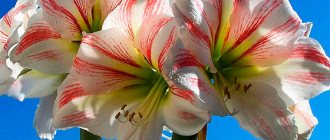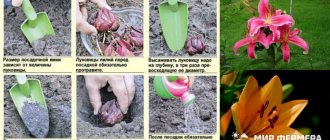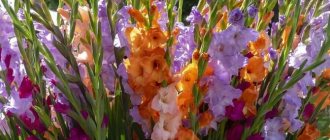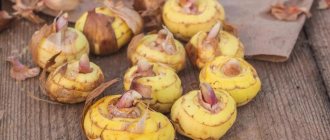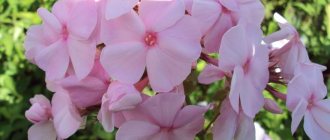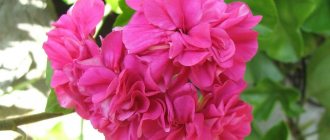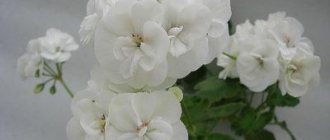Hippeastrum is a tropical plant of the amaryllis family and is found naturally in the Amazon basin of South America. In our climate, this bulbous flower can be grown in pots at home and planted in open ground for the summer. In order for a plant to bloom long and well, it definitely needs a period of rest - once a year for 3 months. Rest time is from October to January. Proper care of hippeastrum in the fall and sending it to rest will help keep the bulb healthy and form a strong flower arrow with large flowers by the next season.
Substrate
To plant the bulbs you will need a light substrate. If possible, it is better to cook it yourself. To do this, for 1 liter of soil mixture you need to take 2 parts of leaf soil, 1 part of coarse sand and 2 teaspoons of superphosphate. Phosphorus is necessary for the plant to bloom brightly and spectacularly. Add half a teaspoon of dolomite flour and 2 teaspoons of ash. Mix everything thoroughly.
If it is not possible to make the substrate yourself, you can take ready-made soil for flowering plants.
Winter care rules at home
Those Hippeastrums that do not sleep in winter or wake up in January need care. It is important to keep them not on a frozen window, but at some distance from cold glass. It is important that sunlight falls on them.
Drafts will also damage plants. Water moderately; you can simply stop watering for a month or a month and a half. Flowering plants can be provided with additional lighting .
Dormant plants do not require care. After a month of rest, they need to be examined every week so as not to miss the moment of awakening.
Bulb
It is recommended to prepare the bulbs for planting at the end of February. To do this, you need to remove all the old soil and carefully inspect the bulbs. Rotten parts, if any, should be removed if they did not fall off with the old soil. Clean the neck and bottom of old scales, this is where all the infection accumulates. We cut off dead roots; those that are too long can be shortened slightly. If you find a fungal infection, you need to treat the plant with a fungicide and then dry it for 3-4 hours.
Viable children, if they are formed, must be carefully separated and planted in separate pots.
Why doesn't the plant go to rest?
Bulbs up to three years of age and those with less than 4 leaves do not need rest . They can be left in their place and watered in moderation.
Sometimes mature plants feel good after flowering, grow foliage and are not going to retire. If they continue to bloom, there is no need to worry, it means the flower has such a rhythm of life.
If Hippeastrum does not retire, but does not bloom, it must be forced to rest.
Watering
Watering should be moderate until the flower shoot or a sufficient number of leaves grow. Very carefully, without pouring on the onion itself, but only along the edge of the pot, you need to water the freshly planted onion with warm, settled water.
Watering is carried out in this way only for the first time. Subsequently, twice a week, the pot is placed up to its shoulders in a bowl of water. The bulb and soil in the pot will absorb as much moisture as required.
The pots are placed on a well-lit windowsill, but the plant must be protected from direct sunlight, otherwise burns may occur. The room temperature should be moderate, from 17 to 23 ˚С.
Hippeastrum needs good lighting even after flowering, since without it the bulb and seeds in the box will not be able to fully ripen for the next planting.
How to send a plant to sleep if it doesn’t go to sleep on its own?
Hippeastrum must sleep , this is the only way to regulate its flowering period and improve vegetative development.
They do it in different ways:
- Stop watering and remove from light. After 3-4 days, remove the plant from the pot, wrap it in several layers of newspaper and put it away in its sleeping place.
- Having stopped watering, place the pot in a cool, dark place on its side, as if putting the plant to sleep. Place the pot vertically after 3 months.
- They simply move the pot into the pantry or underground and forget about it for 2-3 months.
Wake up the plant using standard methods: take it out into the light and begin to water it little by little.
Where to start caring for hippeastrum in the fall
Already from August - September the plant needs to be prepared for rest. From this time on, it is watered less often and from the beginning of autumn, watering and fertilizing are completely stopped for 1 month. During this time, the leaves will naturally begin to wither and turn yellow.
To be able to better build up the root mass, after flowering the stems need to be cut off and seed pods should not be allowed to form. In the summer, after the flowers have withered, you can apply phosphorus-potassium fertilizer. This will strengthen the bulb.
Autumn plant care includes the following manipulations:
- Excavation of hippeastrum.
- Leaf trimming.
- Cleaning each onion.
- Treatment for disease prevention.
- Drying the bulbs in the room.
- Cleaning for storage.
Let's look at all the stages in more detail.
Digging up hippeastrum in preparation for winter
Home care for this tropical plant should include cleaning up for storage after the long flowering season has ended. In nature, there are also ever-flowering representatives of amaryllis, but almost all varieties that we sell need a period of rest for some time in order to accumulate strength and recover.
If a flower grew in the open ground in a flower bed in summer and bloomed again, it should be given more time to prepare for hibernation. You need to wait until the leaves fade on their own.
Dig up bulbs after frost - closer to November.
Indoor flowerpots will need to be sent to winter on their own and you will need to start preparing for this in August, reducing watering. After the soil in the pot dries out, a month after the cessation of moisture, the flower is removed from it and cleaned of soil.
Pruning hippeastrum before wintering
Yellowed leaves on the bulbs need to be cut off at a height of 2 - 3 cm. If it is necessary to adjust the time for forcing the plant, you can begin to retire it earlier. To do this, it is possible to trim leaves that are still green.
Important! The longer the foliage remains on the bulb, the more nutrients will go to the root. It is better to let the leaves wither on their own.
Bulb stripping
After trimming the leaves, you need to remove the roots. The bottom is cleaned completely, cutting off the roots with a sharp knife. The top layer of scales must also be removed. This will help get rid of the soil and any pests or microbes that have settled there. After peeling, you should be left with a white, clean onion.
Treatment for diseases
Already cleaned hippeastrum bulbs need to be placed in a solution of preparations for disinfection. To prevent or treat pest damage, use insecticides. A solution of “Aktara” and “Beetle eater” will help against the most common enemy of hippeastrum - mealybugs - 4 ml and 3 mg of each, respectively, per 5 liters of water. Dilute each separately and then mix together - you get 10 liters.
Dip the bulbs into the resulting solution and leave in it for a couple of minutes. The liquid will saturate them and destroy microorganisms that have penetrated between the scales.
After this, immerse the bulbs in a fungicide solution to prevent the appearance of mold and rot during storage. For example, “Maxim” is suitable, dilute 4 mg in 2 liters of water.
Drying
After processing, the bulbs can be laid out on newspaper and left indoors to dry for a couple of days. They must be completely dry before storing.
Laying hippeastrum for wintering
Dried bulbs must be stored in a cool, dry, dark place for 3 months. at this time.
To prevent the bulbs from drying out, they can be put in a box and sprinkled with dry sawdust, covered and placed in a room with a temperature of 10 - 15 degrees. Humidity should be at 50 - 60%, but not more than 80%. If the temperature is below +5, the bulbs will be damaged, if above 18, they will wake up faster and release the stem.
During storage, the hippeastrum needs to be checked periodically; as soon as the leaves appear, it is planted in a pot slightly larger in size than an onion, and they begin to water it. Young plants overwinter in a pot with soil, which can be watered once per winter. Place it away from windows and radiators.
As you can see, caring for hippeastrum in the fall is not difficult, but it is very necessary for the plant to lay a strong flower bud and bloom well the next year.
Preparing amaryllis for the dormant period
The dormant period for amaryllis is the end of autumn and the beginning of winter. For hippeastrums, the dormant period begins after the plant has flowered, because hippeastrums can be driven out at any time of the year, and not just at the end of summer or early autumn. Early forcing in autumn or late is possible - then the hippeastrum blooms at the end of winter or beginning of spring. Some varieties bloom even in summer.
But whenever your amaryllis or hippeastrum blooms, it needs a period of rest. So far, only one evergreen species of hippeastrum is known - Hippeastrum Papilio, for which there is no need for a dormant period. The remaining varieties of amaryllis and hippeastrum should rest. If you planted amaryllis or hippeastrum in the ground for the summer, then you need to dig its bulb out of the ground before frost and store it in a cool, dark, dry place.
- Two ways to plant onion seedlings in the ground
Review of the best varieties of yellow hippeastrum
Yellow hippeastrums are not the largest group among other species. Includes several popular varieties, differing in color intensity, flower shape and peduncle length.
Marilyn
Hippeastrum Marilyn (Marilyn) belongs to the double varieties. It has flowers of a noble creamy color with a greenish tint, wavy edges and tips curved upward. Up to 4 flowers are formed on one peduncle.
Reference . The name is given in honor of the famous Hollywood blonde Marilyn Monroe due to the resemblance of the petals to her famous hairstyle.
Lemon lime
The variety Lemon Lime (Lemon and Lime) with a height of up to 55-60 cm and elegant flowers with a diameter of up to 12 cm has the following distinctive features:
- flowers of a diluted yellow-green palette with wavy edges and horn-like projections on the back;
- lime spout.
Reference . It has virtually no odor, but blooms very well. Can fire 3-4 arrows at a time. Needs intensive bulb care.
Graffiti
Graffiti is a greenish-yellow flower in the Papilio style with red stripes. It has wide petals with pointed tips curved inwards and a greenish neck.
Emerald
Hippeastrum Emerald (Emerald or Emerald) up to half a meter high during the flowering period is covered with 4-6 flowers with a diameter of up to 10 cm. The uniqueness of the plant lies in its color : pale green flowers with long and narrow petals dotted with myriads of red specks. A scarlet border runs along the edge of the petals. The stamen filaments and pistil are long and white-green.
Reference . Due to the durability of the flowers and peduncles, the variety is considered suitable for cutting.
lemon
Limona (Lemon or lemon mint) - a specimen with large creamy-yellow flowers with a diameter of up to 20 cm. There are up to 4 flowers on the peduncle. The neck is greenish with a poorly defined bit. In the central part of the oval petals with sharp tips, a predominance of pink shades can be observed . The edge is wavy, the stamen filaments are greenish, the pollen is yellow.
Magic green
Magic Green (Magic Green) is one of the most popular varieties . It has buds of various shapes, pale yellow petals with red shading, a green core and a pink or yellow pistil. The diameter of the flower does not exceed 15 cm.
There are also less popular plant varieties with similar colors.
Evergreen
Hippeastrum Evergreen (Evergreen) with pointed and slightly wavy lemon-colored, odorless petals.
Debunking myths
Myth No. 1. In order for the hippeastrum to bloom, you need to cut off the leaves and roots, wrap it in newspaper and put it in a cold and dark place for a month. This advice gives rise to a great desire to hit the adviser on the head.
Axiom No. 1. Only mature bulbs that have been well fed over the previous TWO seasons bloom. The arrow grows from a flower bud established in the penultimate growing season. An adult bulb is from 5 cm in diameter, “grandmother’s” and some species can bloom at 3 cm, but not necessarily. Anything smaller than 5 cm is automatically considered a baby, even if last year it was a gorgeous bulb the size of a fist and bloomed with three flower stalks.
Axiom No. 2. Leaves should never be cut off under any circumstances. Dot.
When the leaf dries on its own, most of the nutrients return to the bulb. If you cut off the leaves, you will deprive the bulb of some of the nutrients it needs for proper rest, and you will also drive it into extreme stress. More about stress later. About the cold and darkness later too.
Axiom No. 3. You can cut the roots. BUT! Only the most extreme thin roots. Long, thick roots also store food, take a long time to grow, and in general the bulb does not do well without them.
Myth No. 2. “For hippeastrum to bloom, you need a small pot so that only your finger can fit between the bulb and the wall of the pot.”
Axiom No. 4. A small pot falls under the weight of a head of flowers, take care of your nerves.
Axiom No. 5. For flowering, a good bulb does not care about the size of the pot. It will flourish even without a pot, in a glass with beads. In a small pot, the bulb will flourish due to internal resources, in a large pot – due to nutrients from the soil. Want a disposable plant? Glass with beads. Do you want to enjoy yourself for many years? The pot should be at least twice as wide as the bulb and deep in proportion to the width, no bowls.
Myth No. 3. Dutch bulbs bloom once and disappear.
Without axioms, lies and provocation. Where do our collections come from then? The main thing is normal care, and our Dutch women live for decades.
Hippeastrum or amaryllis?
Hippeastrum comes from South America and belongs to the amaryllis family. Externally, hippeastrum is similar to another famous plant - amaryllis belladonna from South Africa. We talked about it in the article indoor bulbous plants. Confusion with the names of the plant goes back very deeply, to Carl Linnaeus. Back in the 18th century, Linnaeus accurately identified the plant family and assigned the hippeastrum the funny name amaryllis horseman, horse amaryllis (Amaryllis equestris). Presumably, he saw in the beautiful flower a resemblance to the head of a horse. In the 19th century, another prominent botanist D.W. Herbert, during a more detailed study of Amaryllis equine, noticed that the similarity with Amaryllis beladonna is rather superficial. Herbert identified the first as a separate genus, reflecting in the Greek name the connection with the horseman: hippeastrum, or star of the horsemen. Although hippeastrum has long belonged to its own genus, many people call the plant by its old name: amaryllis, or amaryllis - hippeastrum .
Other plant problems
Hippeastrum also encounters other problems, due to which the condition of the flower can significantly deteriorate:
- Stagonosporosis or red burn. As a result of this fungal disease, leaves and tubers become covered with reddish spots and small stripes. The plant may die due to deformation incompatible with normal development.
- Viral mosaic. Appears as green spots on the leaves. The disease is practically incurable and eventually leads to the death of the flower.
- Rotting of the tuber can occur due to excessive soil moisture when liquid falls directly on the bulb. In this case, the foliage withers and changes color.
- The enlarged bottom prevents the development of roots and leaves, as a result, living scales die off, and new ones grow weakly.
- The hippeastrum bulb can function fully for 15 years or even longer, provided proper care is provided. But if it is small, then the normal development process is disrupted.
In most cases, the process of yellowing of hippeastrum leaves is a natural process associated with the beginning of the dormant period.
In this case, there is no need to worry about the condition of the flower; the leaves will die naturally and resume growth during the next flowering. Various ailments and pests that can lead to the death of the plant should cause concern. The most dangerous disease in this case is red rot, which causes serious deformations and does not allow the hippeastrum to fully develop.
Landing
When to plant?
Hippeastrum can be planted from October to May. Planting material is planted in the ground a month before the planned flowering date. It is preferable to plant the plant when daylight hours begin to noticeably lengthen - from the end of December. The longer the daylight hours, the more abundant the flowering.
Advice. If you purchased several bulbs, do not plant them at once, but at intervals of about two weeks. Then they will not bloom at the same time and will delight you with flowers longer.
For those who want to get a blooming hippeastrum for Christmas, the Christmas Gift and Merry Christmas varieties have been specially bred - ideal Christmas gifts for lovers of potted flowers.
Preparing the bulbs
Before planting, the bulbs should be rinsed for a few minutes in warm water to prevent the development of nematodes. During washing, the dry upper scales usually come off, and a beautiful light green bulb appears to our eyes if it is healthy. After washing, before planting, you should treat the planting material with a fungicide and wait until it dries.
Soil preparation
The optimal substrate for hippeastrum should be:
- humus;
- permeable;
- disinfected;
- with pH 6-7.
You can use ready-made mixtures of so-called universal soil for indoor plants and add garden chalk and perlite to it. Peat and coarse sand mixed in a volume ratio of 1:1:1 can be added to the substrate.
In an acidic substrate with a pH less than 5.5, hippeastrum takes root poorly and flowering is delayed. Therefore, it is recommended to maintain the pH at 6-7. Calcium deficiency affects shoot fragility. Before planting, the substrate should be watered abundantly.
Choosing a pot
The pot for hippeastrum should be slightly larger than the bulbs. When choosing a suitable container, it is necessary to take into account the rather large size of the bulbs, which can reach 20 centimeters in diameter.
The pot is selected so that there is a distance of 2 fingers (about 4 cm) between the bulb and the edges of the container on each side.
Containers must have drainage holes; be sure to add a drainage layer (expanded clay, small pebbles) to the bottom.
Planting, post-planting care
We do not bury the bulb deeply so that leaves and peduncles can grow freely from the top. Plant so that 1/3 of the bulb sticks above the ground. Some gardeners plant even half above the ground. After planting, press the soil firmly around the bulb to ensure it is stable. If the bulb is very large, it is better to insert the pot into a heavier base.
Immediately after planting, carry out the first, abundant watering and transfer the pot to a warm place with a temperature of 20-23 degrees, with plenty of light. An east or west window sill will work well. In the following days, water moderately. Hippeastrum grows quite quickly if it has access to sunlight and heat.
We maintain this state until the hippeastrum begins to bloom. When the flowers appear, we look for a slightly cooler place for it and water it more. Thanks to these two procedures, the plant will be able to better color the flowers.
Pests and diseases
The following pests most often attack hippeastrum:
- Narcissus fly (Lampetiaequestris ) - its larvae destroy the insides of the bulb. Insects are active from spring until the end of June, so until then it is better not to take the plants outside.
- Thrips feed on leaves. Symptoms include silvering of leaves and black lumps of droppings.
Common diseases of hippeastrum:
- Red spot is a fungal disease caused by the fungus Phoma narcisii (synonym Stagonospora curtisii). Symptoms: red spots on onion skins, roots, base of leaves. This is the most dangerous and most difficult disease to fight. Fungicides can be used, but there is no guarantee of getting rid of the fungus. The fungus spreads quickly, causing slow growth and death. The development of the disease is favored by cold temperatures and excessive deepening of the bulb during planting.
- Rotting of roots and bulbs - the cause of the disease is too wet a substrate, excessive watering. Rotting parts can be removed, a fungicide applied, or the substrate changed. Rotting stains can be sprinkled with cinnamon after cleaning.
- Mosaic disease is a virus that causes discoloration and streaking on leaves and flowers. The diseased plant must be destroyed.
How to wake up a flower after wintering?
As soon as the plant begins to throw out a peduncle, it needs to be taken to a permanent place and watering and care begin. If necessary, transplant into a new pot.
If the plant does not wake up by the appointed time, which is February or April, depending on the time of sending to rest, it will have to be awakened. To do this, take the flower pot to a warm sunny place and start watering. After 20 days or less, the flower will begin to produce its first leaves. Do not leave water in the tray. Otherwise, the bulb will begin to rot.
By following these simple rules of care and maintaining a period of rest, you can achieve good development and flowering from your phytopet.
Reproduction
Propagation by seedlings
Growing new plants is carried out by sprouting seeds into seedlings, by dividing the bulbs into parts, and also with the help of children. The seed method is rarely used because it is associated with many difficulties and associated procedures to ensure this process.
Reproduction by children
The method of propagation by children is most often used by gardeners. The baby is separated from the developed healthy bulb at the time of plant transplantation. This is done with a sharp, disinfected knife, treating the cuts with charcoal powder after separation. After this, the baby is placed in a separate pot.
Propagation by bulbs
The method of dividing the bulb is also used quite rarely. There are also some special methods to ensure lush and abundant flowering of the plant, twenty days after planting.
One of them will be placing a young onion in warm water at a temperature of up to forty-five degrees Celsius for a period of three hours. After this procedure, it is immediately placed in an earthen substrate.
What problems and difficulties may arise?
When breeding a flower, the following problems may arise::
- When dividing an insufficiently large bulb, the plant may not develop, because it has not accumulated enough nutrients.
- If you use unsterilized instruments, there is a high probability of contracting fungal infections.
- If the cut is unclear, when the baby is separated into the bulbs, putrefactive processes may develop at the cut sites.
- When using warmly stored seeds, their germination rate will be very low; it is better to take freshly harvested seeds or seed stored in laboratory conditions.
It is quite possible to propagate hippeastrum at home. However, it should be remembered that its flowering begins after several years when grown at home. It is preferable to choose a vegetative propagation method, and propagation by seeds only to obtain new varieties.
